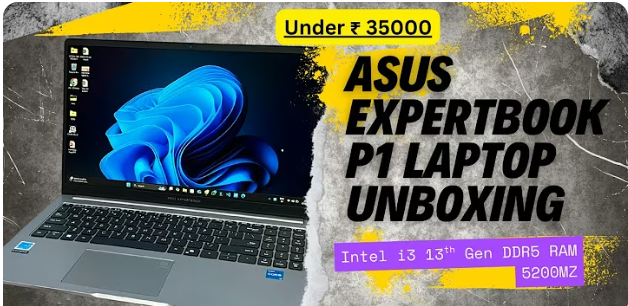Introduction: ExpertBook P1 vision and target audience
The Asus ExpertBook P1 is a business-class laptop designed for professionals and small business users who want a reliable, secure and long-lasting machine — without unnecessary flair. This laptop is perfect for those who prioritize portability, security and everyday performance, whether for remote work, video meetings, documentation, light multitasking or coding.
Design and Build Quality
Finish and material: Misty Grey matte finish gives an understated and professional look. Exterior is plastic, but internal reinforced metal chassis makes the structure look sturdy.
Weight & dimensions: The 14‑inch model weighs approximately 1.4kg, which is lightweight for commuting and travel. The 15.6‑inch variant is slightly heavier, starting at 1.6kg.
Durability certifications: Tested under US MIL‑STD‑810H standard. Features include spill resistance and pressure tolerance, with a design to handle up to 66cc of water spillage on the keyboard.

Display & Visual Experience
Screen specifications: 14‑inch or 15.6‑inch Full HD (1920 x 1080) IPS/TN panel, 16:9 aspect ratio, anti‑glare coating, around 300nits brightness and supports ~45% NTSC gamut.
User experience: Readability is good in indoor environment, glare is minimal. But in strong sunlight, detail can be missed due to low brightness and limited colour gamut.
Bezels & design feel: Bezels are relatively thick, chin is noticeable – looks a little dated, but not a major issue for business use.
Read More on offical page
Performance & Hardware Specifications
Processor options
- Intel versions: Core i3‑1315U / i5‑13420H / i5‑13500H / i7‑13620H / i7‑13700H configurations available with upto 10‑14 cores and upto 5.0GHz turbo frequency.
- There are also AMD variants: Ryzen 57535HS and Ryzen 77735HS options, which deliver better efficiency and performance with integrated Radeon GPUs.
- Memory support: 8GB ya 16GB DDR5 configurable, dual‑channel up to 64GB possible. Dual‑slot expandability for future upgrades.
- Storage options: 256GB / 512GB / 1TB NVMe PCIe 4.0 SSD. Some variants also offer dual‑drive configuration (RAID1).
Graphics
- Integrated graphics are provided by: Intel IrisXe (i5/i7 models), or AMD Radeon660M/680M GPU (AMD variants).
- Not suitable for gaming or heavy video editing — fit for light productivity and casual light media tasks.
- Benchmarks & Real‑World Performance
- Cinebench R23 shows multi-core around ~5800 (Intel i5 configuration) benchmark results. Geekbench single-core approx 1860 and multi around 5714.
Real life use: multitasking, Office apps, coding, light VM work runs smoothly — fan sound also at reasonable level.
Explore More Products
Keyboard, Touchpad & Input Interface
keyboard
Chiclet-style keyboard with full num-pad (15.6‑inch variants), approx 1.35mm key travel, spill‑resistant design. Typing is comfortable for extended sessions.
Backlit option available with multiple brightness levels; Copilot key is also included in the function row.

Touchpad & Fingerprint Sensor
Precision touchpad with smooth gesture support, click feedback is satisfactory.
The touchpad has a built-in fingerprint sensor in the right‑top corner, supports Windows Hello and FIDO2 encryption.
Ports & Connectivity
USB ports: 2 × USB‑A 3.2 Gen1, 2 × USB‑C 3.2 Gen2 (support DisplayPort and Power Delivery).
Video: HDMI 1.4b port (max 4K@30Hz). 1440p monitor and charging simultaneously possible from USB‑C port.
Ethernet: Full-sized RJ45 Gigabit LAN port available — rare feature in thin laptops, but handy for reliable wired networking.
Audio jack: 3.5mm combo headphone/mic jack. Kensington Nano lock slot for physical security included.
Wireless Connectivity
Wi‑Fi 6 or Wi‑Fi 6E (Intel/AMD variant dependent) dual‑band with Bluetooth 5.4 support.

Security & Privacy Features
TPM 2.0 support, BIOS‑level passwords, fingerprint sensor, Kensington lock slot, BIOS self‑healing & downgrade protection, chassis intrusion detection, webcam privacy shutter.
In-device security built for enterprise environments.
Battery life & Charging
Options: 42Wh / 50Wh / 63Wh battery capacities. Charging via USB‑C (65W charger supporting PD and PPS).
Real‑world battery life varies: lighter Intel U-series (~5‑6 hours typical). H-series chips (i5‑i7) heavier power consumption; expect ~5 hours under office usage.
AMD versions likely offer better efficiency, though exact mileage depends on variant & usage.
AI Features & Software Suite
MyASUS suite pre-installed, including features like system diagnosis, fan profile control, battery health charging, link to phone, Splendid / Tru2Life visual enhancements.
Dedicated Microsoft Copilot key: quick access to AI assistant.
AI ExpertMeet app (available on units with adequate RAM): offline meeting transcription, summary, gaze correction, background lighting optimization, motion tracking and watermark generation — especially useful for hybrid work scenarios.
These features streamline remote collaboration and meeting management.

Weak Points/Limitations
Display limitation: low NTSC coverage (~45%) means color accuracy weak — not recommended for content creators or designers.
Webcam: 720p resolution only, good in bright light but grainy in low-light. Physical shutter included but image quality basic.
Build material feel: Plastic casing feels ok, but not premium as aluminum laptops. Some users report slight creaks or fan click noise when spinning starts — though majority satisfied with build quality given price tier.
Battery limitations: higher‑end configurations consume more power; Battery life average in busy day with heavy multitasking.


Linux Compatibility
Users have tried Ubuntu/Fedora installations. Core components — WiFi, Bluetooth, keyboard — generally work, but secure boot toggling and BIOS quirks may cause issues.
Secure Boot may not recognize Linux certificate keys; disabling secure boot required for Ubuntu usage. BIOS toggles sometimes buggy — caution advised for dual boot configurations.
Pricing & Value Proposition
India mein starting price around ₹68,990 (e.g. Intel Core i5, 8GB RAM, 512GB SSD) — excellent value given port selection, security features, MIL‑STD durability and AI enhancements.
Benchmarks and real‑world performance recommend it strongly for office use, remote work, students, small businesses.
Use Case Scenarios & Recommendation
Office Professionals / Remote Workers
- Frequent video calls (Copilot key + ExpertMeet tool), document work, emails, meetings.
- Wired or Wi‑Fi connectivity options robust. Privacy shutter and security features add extra assurance.
Students/Developers
- Code compilation, VM usage, research, assignments — dual‑slot RAM/SSD upgrade enables future-proofing.
- Lightweight and portable for campus movement.
Travel & Hybrid Workers
- Compact size, USB‑C charging convenience, MIL‑STD rating for durability. Ethernet port handy in hotel/business setups.
Not ideal for
- Heavy graphics work, video editing, AAA gaming — due to integrated graphics & limited color coverage.
- Designers or colour-critical workflows.
Final Thoughts: Which one to buy?
The ExpertBook P1 is a smart choice for those who want reliability, portability, security and useful AI-enhanced features, without extra gaming or high-end editing capability.
If you need a laptop that can handle everyday business tasks, video conferencing, light development and offline/online meetings, this budget-friendly yet functional laptop will meet your needs.
Build quality, port variety, security suite and AI enhancements are a rare combination at this price point. Yes, the display and GPU power are entry-level — but if your work is limited to business productivity and office use, this is ideal.



1 thought on “Introduction: ExpertBook P1 vision and target audience”